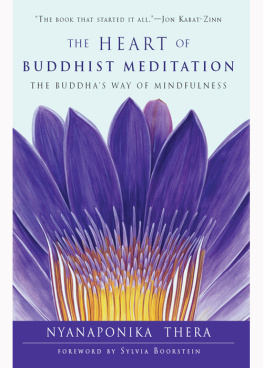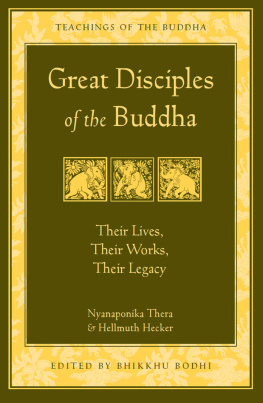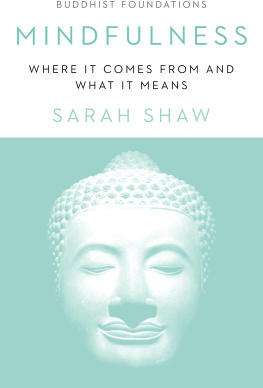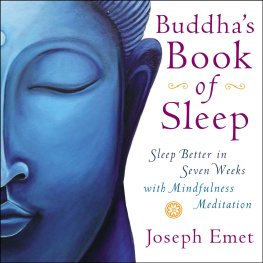This is the book that started it allthe book that, with great clarity and ardor, introduced Vipassana and mindfulness to the West. I still have and cherish my dog-eared, heavily underlined and annotated copy from way back whenwith the price tag still on it: $3.00. Of course its content is timelessand universal. All teachers of mindfulness-based programs would do well to carefully read and re-read this book and reflect upon the ways in which mindfulness is described in terms of both bare attention and clear comprehension.
Jon Kabat-Zinn, author of Mindfulness for Beginners and Full Catastrophe Living
The Heart of Buddhist Meditation is a work of unique importance in the literature about meditation. It is written with great depth, extraordinary knowledge, deep humanity, and in a style that is simple and direct. Although written from the Buddhist thinking, it is of equal value to the non-Buddhist reader. I highly recommend it to anyone who is seriously concerned with self-development.
Dr. Erich Fromm
An appreciated contribution to the development of Buddhism in the West.
Karuna: A Journal of Buddhist Meditation
It's wonderful to see this new edition of an invaluable, classic meditation guide. Nyanaponika Thera's The Heart of Buddhist Meditation is sure to benefit many.
Sharon Salzberg, Co-Founder of The Insight Meditation Society

This edition published in 2014 by Weiser Books
Red Wheel/Weiser, LLC
With offices at:
665 Third Street, Suite 400
San Francisco, CA 94107
www.redwheelweiser.com
Copyright 1954, 1962, 1996
Buddhist Publication Society
54, Sangharaja Mawatha
P.O. Box 61
Kandy, Sri Lanka
Foreword 2014 Sylvia Boorstein.
All rights reserved. No part of this publication may be reproduced or transmitted in any form or by any means, electronic or mechanical, including photocopying, recording, or by any information storage and retrieval system, without permission in writing from Red Wheel/Weiser, LLC. Reviewers may quote brief passages. First published in 1962 by Rider & Co., London.
The moral right of Nyanaponika Thera to be identified as the author of this work is asserted.
ISBN: 978-1-57863-558-0
Library of Congress Cataloging-in-Publication Data available upon request.
Cover design by Jim Warner.
Cover art: Drawing 8/7 Nymphaea capensis var. zanzibariensis (Cape Blue Water-Lily) 1907 (watercolour on paper), Church, Arthur Henry (1865-1937) / Natural History Museum, London, UK / The Bridgeman Art Library
Interior by Frame25 Productions
Typeset in Brill.
Printed in the United States of America.
EBM
10 9 8 7 6 5 4 3 2 1
www.redwheelweiser.com
www.redwheelweiser.com/newsletter
Contents
Foreword
The Heart of Buddhist Meditation was the first serious, didactic Dharma book I read. It was the early nineteen-eighties. My teacher, Jack Kornfield, suggested it as the beginning of formal training to become a Mindfulness teacher. I have that original copy, and I am touched by how many underlined passages, how many exclamation points in margins, and how many addenda of my own written in tiny scrawl appear in its fading pages. I had been a serious practitioner for more than five years by that time, a participant at many retreats, and an ardent, inspired listener to Dharma talks. My own discoveries about suffering and the end of suffering as I experienced them had kept me committed. When, as a way of providing formal, authoritative, academic background for me as teacher, I began to read the works of the Venerable Nyanaponika Thera, I not only felt that I understood the whole process of what was happening to me in a fuller way, I felt as though I were adopting the Venerable Nyanaponika as my spiritual grandfather. I still feel that way.
Apart from the meticulous yet accessible writing style with which the Venerable Nyanaponika builds every point, I feel a warmth and friendliness in his tone that makes me feel as if he is talking to me. The fact that I feel him as family is multi-layered, I'm sure. My father, whom I greatly admired, was a wonderful high school mathematics teacher who taught me to swim and solve puzzles and ice skate. I always felt that he taught things he loved to people he loved. Like Nyanaponika Thera, my grandfather, with whom I was very close all of his ninety-eight year life, was a Jew born in German-speaking Europe. Although unschooled, he liked to talk to me philosophically. I felt, from my family teaching me and talking to me, that I was well cared for and respected. I feel the same reading Heart of Buddhist Meditation.
Look at this example, and see if you don't feel uplifted and cared for and inspired:
In the actual, and not merely conceptual, confrontation with the fact of Impersonality, as afforded by Bare Attention, its full gravity will certainly make itself felt strongly, in consonance with the gravity of entire existence of which it is the most significant fact. But this will not be the only emotional experience issuing from the awareness of Anatt (Impersonality). Testimonies of ancient and modern meditators speak of moods of lofty happiness covering a wide range from rapture and exultation to serene joy. They are expressive of the exhilaration and relief felt when the tight, vice-like grip of I and Mine loosens; when the tension it produces in the body and mind is relaxed; when we can lift, for a while, our heads above the fierce current and whirl in which the obsessions of I and Mine engulf us; when there is a growing awareness that the very fact of Impersonality holds open for us the door to Liberation from the Ill which was sensed so poignantly in what we called the grave aspect of Impersonality.
(The bold-type addition to that text is mine.) In my thirty year old edition of this book, that paragraph is heavily underlined and exclamation pointed. I love it! I hear it as Dharma poetry.
The Heart of Buddhist Meditation sits on my book shelf next to The Vision of Dhamma, a later collection of essays from the Venerable Nyanaponika Thera. Amidst dozens of Dharma books, they are my most referenced and most consulted. When I read in Vision that he uses tidying to describe the effect that mindfulness has on the mind, I could hear the echo of his German, Victorian mother in his word choice, and perhaps that added yet another layer to my feeling that Nyanaponika Thera is familiar to me. I do believe, though, that it is the Venerable's expansive heart and ardent hope to spread these liberating teachings to all seekers that will make him feel familiar to you as well, whoever you are.
Sylvia Boorstein
July 24, 2013
Introduction
The Heart of Buddhist Meditation
The purpose of these pages is to draw attention to the far- and deep-reaching significance of the Buddha's Way of Mindfulness (Satipa
 hna), and to give initial guidance to an understanding of these teachings and their practical application.
hna), and to give initial guidance to an understanding of these teachings and their practical application.
This book is issued in the deep conviction that the systematic cultivation of Right Mindfulness, as taught by the Buddha in his Discourse on Satipa
 hna, still provides the most simple and direct, the most thorough and effective, method for training and developing the mind for its daily tasks and problems as well as for its highest aim: mind's own unshakable deliverance from Greed, Hatred and Delusion.
hna, still provides the most simple and direct, the most thorough and effective, method for training and developing the mind for its daily tasks and problems as well as for its highest aim: mind's own unshakable deliverance from Greed, Hatred and Delusion.
Next page













